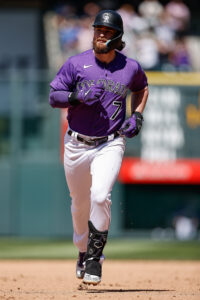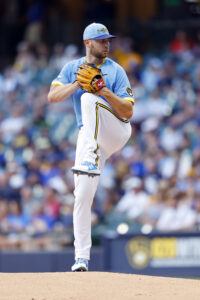The National League East is shaping up as one of baseball’s more competitive divisions in 2023. The defending champion Braves, Mets and Phillies have all made big moves to bolster their already strong rosters, while the Marlins will lean on a quality rotation to try and be competitive. The Nationals are, of course, in full rebuild mode and won’t be among the division’s best this year.
There’s still a chance of one or two significant moves to be made in this division. It’s been reported that Miami has made four of their starting pitchers available in trades, and it wouldn’t be a surprise to see them ship out a starter to bring in an offensive upgrade, possibly an outfielder.
Nonetheless, let’s take a look at each team’s off-season to see how they stack up in this division heading into the new season (teams listed in last year’s standings order).
Atlanta Braves (101-61)
In: C Sean Murphy, LHP Lucas Luetge, OF Jordan Luplow, OF Eli White, LHP Kolby Allard, RHP Joe Jimenez.
Out: SS Dansby Swanson, RHP Kenley Jansen, RHP Darren O’Day, RHP Luke Jackson, OF Adam Duvall, C William Contreras, C Manny Pina.
The Braves big splash of the off-season was their trade for Murphy. In typical Braves fashion, they wasted little time in extending him as well, signing him to a six-year, $73MM pact to lock him in as their catcher of the future. The Braves weren’t struggling at catcher, but the arrival of Murphy is still an upgrade over Contreras and Pina, who were both shipped out in the deal. He’ll join a lineup that is largely the same as the one that won 101 games last season. The big hole remains at shortstop and in left field. Swanson departed for the Cubs in free agency, and the team could either rely on Orlando Arcia or rookie Vaughn Grissom to take over. Eddie Rosario was worth -1.1 fWAR in 2022, but the Braves are paying him $9MM this year and it seems likely he’ll be back as the starter in left. Luplow could get some opportunities to take the starting job on his new team, but he posted a wRC+ of just 78 last season.
In the rotation, Max Fried will be back to lead a starting corp that also features Kyle Wright, Spencer Strider and veteran Charlie Morton. A wretched run of Achilles injuries meant Mike Soroka has only made three starts in the past three seasons, but he’s back and if he can stay fit and return to his 2019 performance he gives the Braves a quality fifth option. The acquisitions of Luetge and Jimenez gives the Braves another couple of quality relief arms to cover the departure of Jansen in free agency.
All told it’s a quality roster that doesn’t appear to be weaker the 2022, but will it be enough to hold off other teams in the division?
New York Mets (101-61)
In: RHP Justin Verlander, LHP Brooks Raley, RHP Zach Greene, LHP Jose Quintana, RHP David Robertson, RHP Kodai Senga, C Omar Narvaez, SS Danny Mendick, RHP Stephen Ridings, RHP Elieser Hernandez, RHP Jeff Brigham.
Out: RHP Jacob deGrom, RHP Chris Bassitt, RHP, Seth Lugo, RHP Trevor May, RHP Trevor Williams, OF Tyler Naquin, LHP Joely Rodriguez, RHP Taijuan Walker, 1B Dominic Smith, RHP Mychal Givens, C James McCann.
The Mets effectively had to overhaul their rotation and bullpen this winter, after a series of major departures in both areas. In a fashion befitting the Steve Cohen-era Mets, they did so in expensive fashion. The Mets quickly offset the departures of deGrom, Bassitt and Walker by signing Verlander, Quintana and Senga to big deals and ensuring their rotation is at least as strong as last year. In the bullpen they re-signed Adam Ottavino, brought in David Robertson and made a series of smaller trades and waiver claims to rebuild their relief group.
Offensively, the Mets didn’t have too many moves to make. The big hole was in the outfield, but the team addressed that by bringing back Brandon Nimmo on an eight-year, $162MM deal. They came close to adding Carlos Correa, but that move broke down over the much-publicized medical concerns. Correa would’ve certainly been a boost to their offense, but they’re still in a good spot without him. They could probably still do with another outfielder, and it’s been reported that they’re interested in the remaining free agent options there (Tommy Pham, Adam Duvall etc).
The Mets led the East for the majority of 2022 and they’ll again be up there in ’23. Perhaps one more major move (like Correa) would’ve sealed them as division favorites, but they’re still in a very good spot as is.
Philadelphia Phillies (87-75)
In: LHP Gregory Soto, INF Kody Clemens, RHP Craig Kimbrel, RHP Taijuan Walker, LHP Matt Strahm, SS Trea Turner, OF Jake Cave,
Out: OF Matt Vierling, INF Phil Maton, C Donny Sands, INF Jean Segura, RHP Noah Syndergaard, LHP Brad Hand, RHP Chris Devenski, RHP Kyle Gibson, RHP David Robertson, RHP Zach Eflin, RHP Corey Knebel.
The Phillies went all the way to the World Series in 2022, but they still finished 14 games back of the Braves and Mets in the division so had a bit of work to do to try and close that gap going into this season. The addition of Turner gives them a superstar at the top of their lineup alongside Kyle Schwarber, J.T. Realmuto and co. If youngsters Alec Bohm, Bryson Stott and Brandon Marsh can take a step forward at the plate this year they’ll have a much deeper lineup. They’ll hope they can do enough to stick with the Braves and Mets in the first half of the season, before welcoming back star Bryce Harper from injury at some stage mid-season.
On the pitching side of things, Walker slots in as a quality third option behind Aaron Nola and Zack Wheeler in the rotation. The bullpen lost a number of players this winter, but the additions of Strahm, Soto and Kimbrel to a group that already has Seranthony Dominguez, Jose Alvarado and Andrew Bellatti should make that area of the team a strength in season.
All told, the Phillies do look a better unit than they were to start 2022, but it remains to be seen whether or not that’ll be enough to make up 14 games on the Braves and Mets – who certainly haven’t taken a step backwards themselves this winter.
Miami Marlins (69-93)
In: INF Jacob Amaya, INF Jean Segura, OF Jake Mangum, RHP JT Chargois, SS Xavier Edwards, RHP Johnny Cueto.
Out: SS Miguel Rojas, RHP Elieser Hernandez, RHP Jeff Brigham, 3B Brian Anderson, RHP Nick Neidert.
The Marlins have had a quiet off-season, but they could be one of the busiest teams in all of baseball, let alone the NL East, between now and the start of the season. That’s because they’ve reportedly made four of their starters – Pablo Lopez, Trevor Rogers, Edward Cabrera and Jesus Luzardo – available in trades. That speculation has only intensified in the wake of them agreeing to a deal with veteran starter Johnny Cueto.
As such, it makes sense to start with a look at their rotation as things stand. Sandy Alcantara isn’t going anywhere and he’ll be back to lead the rotation after winning the Cy Young award in 2022. Beyond Alcantara will be Cueto and then some combination of the four previously mentioned starters. The fact team also has Sixto Sanchez returning as well as Braxton Garrett available shows how deep their rotation options are, but also that they could feasibly deal two starters and still be in a good position in the rotation. In any event, pitching should be a strength for the Marlins in 2023.
Presumably any trade of a starter would be to add a bat to their lineup. The signing of Segura likely filled out their infield, but the team could certainly do with an outfield upgrade. Bryan Reynolds is the highest profile option there, but other options on the could include Max Kepler or a free agent addition such as Pham or Duvall.
The Marlins do look capable of topping last year’s 69-win total as is, but it’d be interesting to see how they’d go with a deeper lineup, and whether or not a swing-for-the-fences-type move such as trading for Reynolds would propel them into the Wildcard conversation.
Washington Nationals (55-107)
In: OF Corey Dickerson, 1B Dominic Smith, SS Jeter Downs, RHP Trevor Williams, OF Stone Garrett, 3B Jeimer Candelario.
Out: 1B/DH Luke Voit, RHP Steve Cishek, RHP Will Harris, 2B Cesar Hernandez, RHP Joe Ross, DH Nelson Cruz, LHP Sean Doolittle, RHP Anibal Sanchez, RHP Erick Fedde, RHP Tommy Romero, RHP A.J. Alexy.
After eight-straight winning seasons between 2012-19 culminated in a championship in 2019, the Nationals are in full rebuild mode. They lost 107 games in 2022, and wouldn’t be a surprise to see them lose a similar amount in 2023. While the new schedule calls for fewer divisional matchups, the Nats certainly won’t be helped by regularly playing in a division with a number of quality teams.
Offensively, the Nationals will look for contributions from youngsters CJ Abrams and Keibert Ruiz – two players they’ll hope to build their next playoff roster around. They’ve also brought in a couple of cheaper bounceback candidates in Smith and Candelario, and both could turn themselves into trade chips at the deadline. It’s a similar story on the pitching side, where they’ll hope Josiah Gray, MacKenzie Gore and Cade Cavalli can show they can be long-term rotation pieces for the team.
While the Nationals are the clear favorite to prop up the group, it should be an interesting battle in the NL East, particularly with the Braves, Mets and Phillies. What do you think? Who will finish top of the East? Have your say in the poll below.


